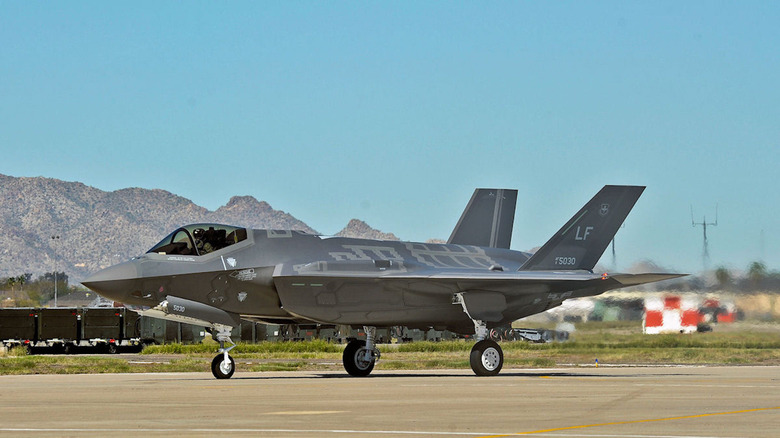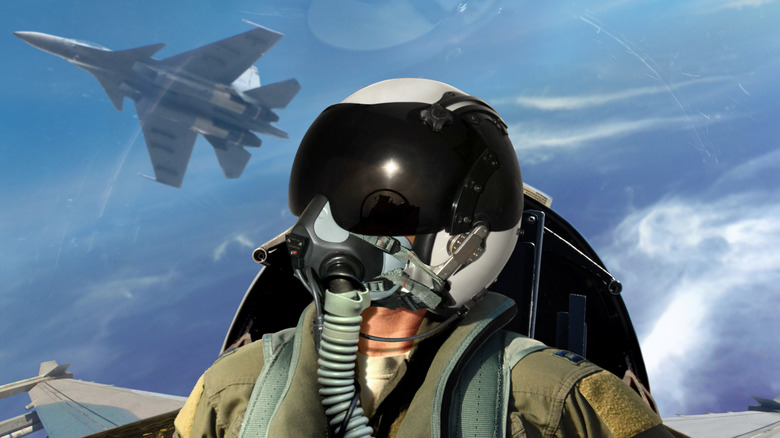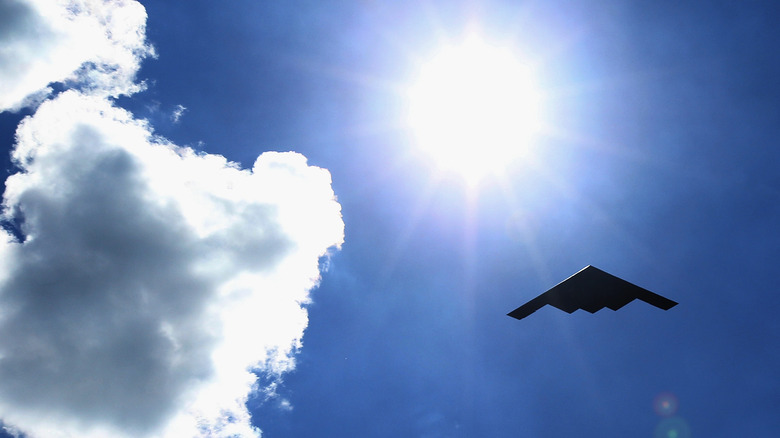Here's Why This F35 Is So Shiny
The F-35 is the U.S. military's latest addition to the realm of aerial warfare. The F-35 Lightning II, according to The U.S. Air Force, is the United States' fifth-generation fighter, being used to replace both the F-16 Fighting Falcon and A-10 Thunderbolt II. According to the Air Force, the F-35 incorporates a stunning sensor array and enhanced takeoff and landing capabilities that make the aircraft a far more versatile tool in any combat effort to dominate the skies above and around a battlefield. What's more, the F-35 is designed with logistical updates in mind as well. This makes the aircraft more reliable and easier to maintain than any previous model deployed by U.S. service members.
The Air Force also reports that the F-35 was designed to replace as many as seven unique aircraft in the loadout capacity of multiple service branches, including Harriers used by the U.K. Popular Mechanics notes that the depth of combat data analysis and management that these new planes bring to bear is what really sets them apart from previous models. The aircraft is a stunning update in both warfighting capacity and in style, to be sure. One thing that's making headlines recently about the new F-35 is the shiny skin that has been spotted on Navy fighters.
The F-35 is a state of the art warplane, and stealth is a part of the allure
One core functionality of any effective military aircraft is the capacity to evade detection by enemy forces. This is true when engaging other air combat units, and when considering the grounded sensor arrays that are used to locate and track aircraft. One of the Navy's F-35s was recently spotted with a shiny, mirrorlike finish throughout the body of the aircraft (via The Drive). The plane in question is deployed as part of the Navy's Air Test and Evaluation Squadron Nine (VX-9), known as the Vampires (via NAVY AIRPAC). Similar mirror finishes have been seen on other aircraft, most notably the F-22. This type of mirrorlike, shiny finish along the body of an aircraft is designed specifically to disrupt radar detection as well as visual identification while flying through the air. Key Aero notes that a wide range of color schemes have been employed throughout air combat history to achieve these aims.
On a previous F-35 model, it was apparent that these tiles would give off a flat gray appearance at one angle and be reflective at another. But this isn't the only technical detail pushed into the F-35 layout. Military Machine reports that 360-degree combat monitoring and awareness are enmeshed in the F-35, and upgrades over ground mapping capacity have pushed what is capable in aerial combat and defensive maneuverability to the limits.
Business Insider notes that these chrome finishes may be applied to aircraft in an effort to shield their signatures from infrared spectrum detection. Of course, stealth is always a must when working with combat vessels, and so the Navy and Air Force have been experimenting with different finishes and aircraft construction to minimize noticeability for as long as air fighting has been a part of war.
U.S. aerial equipment boasts a long history of similar design features
The U.S. military's foray into advanced aerial weaponry hasn't just been an effort to develop faster, deadlier, and bigger weapons systems. Making use of advanced weaponry means developing highly potent systems of attack, but also defensive measures to deliver and safely utilize these offensive weapons. As a result, the military has continuously worked to improve aircraft masking features (via Military History Now), long-range weapon systems, and terrifying war drones which take human operators out of the equation.
Perhaps the most iconic version of this type of masking system can be found in the B-2 stealth bomber and the smaller but similar F-117. These aircraft contained sharp angles and a completely unique overall footprint. Northrop Grumman notes that the B-2 specifically was designed to avoid detection by even the most sophisticated defenses that enemy nations could muster. The B-2 stealth bomber is in a class of its own when it comes to aircraft design and more closely resembles a UFO than a combat aircraft deployed by the U.S. military when viewed from the ground. The military is even working on a more durable spray-on stealth ceramic for its stealth fighters.
Sharp angles, reflective skin, and many other design features have been developed and tested by the U.S. military in an effort to provide service members with the most advanced and capable weaponry imaginable. This means creating both offensive potency and defensive strategy.


